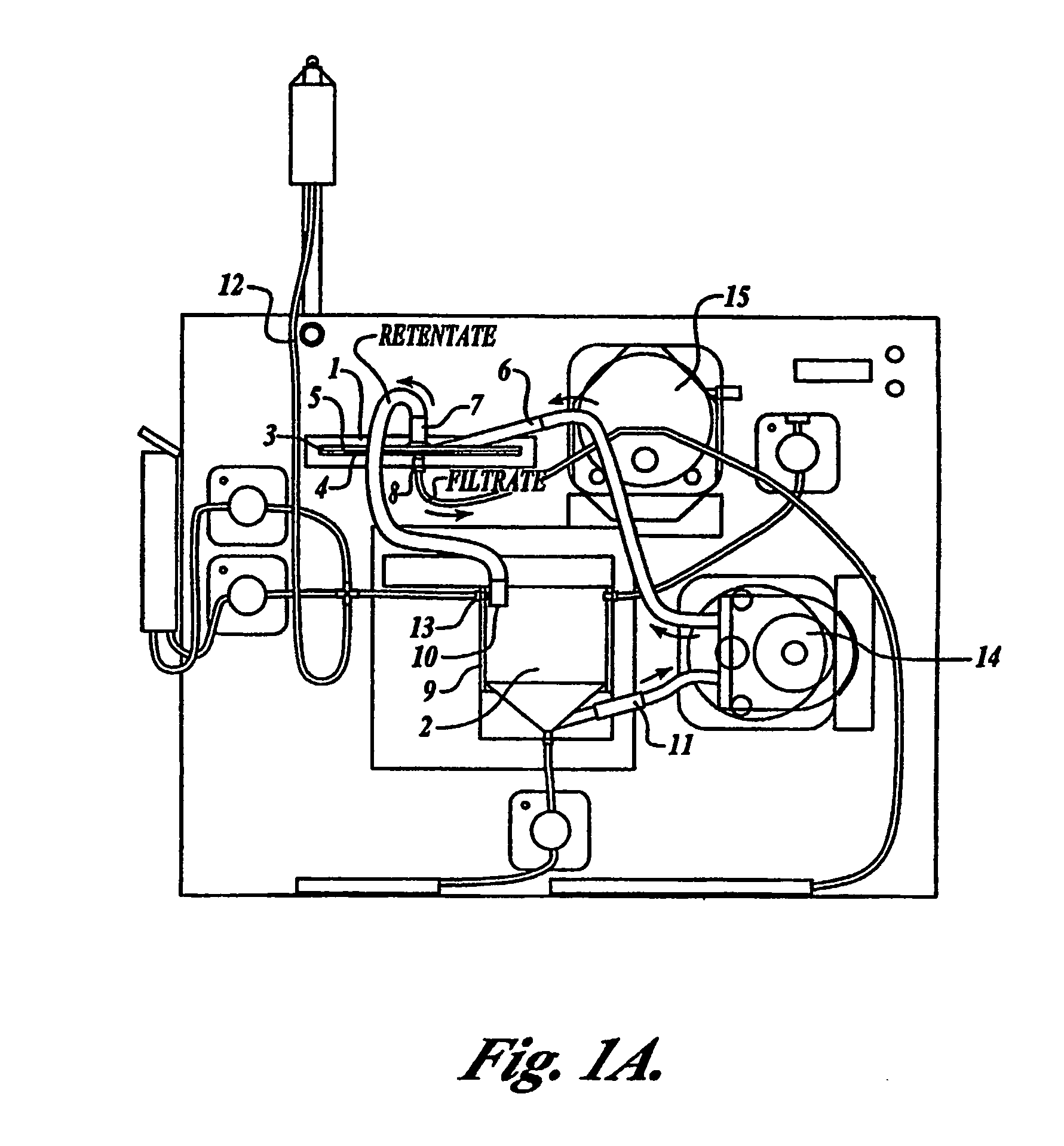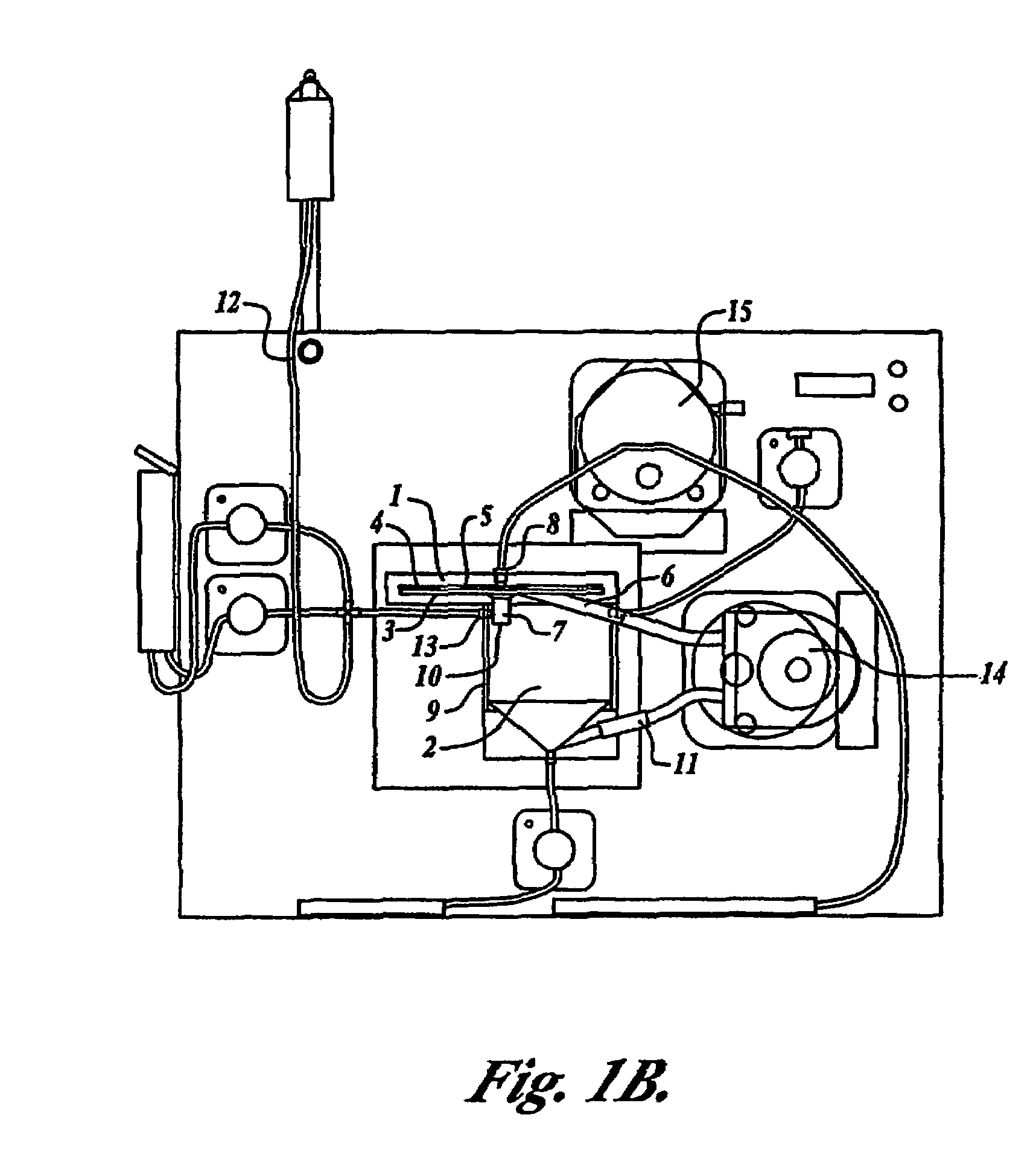Tangential flow filtration devices and methods for leukocyte enrichment
a filtration device and flow filtration technology, applied in the direction of ultrafiltration, liquid separation auxillary apparatus, osmosis/dialysis, etc., can solve the problems of increasing cell lysis, reducing cell viability and cell viability, and the opportunity for bacteria or other infectious agents to contaminate the cells, so as to reduce the filtration rate through the filter
- Summary
- Abstract
- Description
- Claims
- Application Information
AI Technical Summary
Benefits of technology
Problems solved by technology
Method used
Image
Examples
example 1
TFF Device with Remover Unit and Recovery Unit in Loop Configuration
[0090]One embodiment of the present invention comprises a configuration having a remover unit (1) and a recovery unit (2) in a loop configuration of the tangential flow filtration device. (FIG. 1A) The remover unit included a housing having two chambers (a cross-flow chamber (3) and a filtrate chamber (4)), separated by a microporous filter (5) (142 mm in diameter) having a pore size of about 1 micron to about 10 microns. The cross-flow chamber included a fluid inlet (6) and a fluid outlet (7). The filtrate chamber included a filtrate outlet (8). The recovery unit included a housing (9) containing a return inlet (10), a return outlet (11), a sample inlet (12), and a solution inlet (13). In certain embodiments the sample inlet and solution inlet are the same, but can be separate. Sample (e.g. blood, blood preparations, or a prepared population of leukocytes) was introduced into the recovery unit by the sample inlet (...
example 2
Retention of Leukocytes Following TFF—Effects of Recirculation Rate and Filtrate Rate on Retention Efficiency
[0091]In this example the enrichment of leukocytes using a TFF device as described in Example 1, which accommodated polyester membranes of 142 mm in diameter, was demonstrated. A sample of leukopheresis product was subjected to TFF in a device under various conditions, and the selective retention of leukocytes was assessed. In one set of studies, TFF was performed for 10 ml of leukopheresis product using a 3 micron filter, with a filtration rate of 15 ml / min (for 17 min) and at various recirculation (input) rates (e.g., 1680, 1380, 1080, 870, and 540 ml / min). Most of the leukocytes were generally retained in the retentate (i.e., less than about 10 percent of the leukocytes in the filtrate) unless the recirculation rate was lower than 1080 ml / min (FIG. 2; note: the corresponding actual recirculation rates designated Max, 10, 9, 8, 7, and 6 were 1680, 1380, 1080, 870, and 540 m...
example 3
Selective Removal of Erythrocytes From Leukopheresis Product
[0093]In this example the selective removal of erythrocytes and the effects of recirculation rate, filtration rate and sample concentration on the separation efficiency using the TFF device of Example 1 was demonstrated. Samples of leukopheresis product were subjected to TFF under the conditions as established in Example 2, and the selective removal of erythrocytes was assessed. As in Example 2, TFF was performed for 10 ml of leukopheresis product using a 3 micron filter, with a filtration rate of 15 ml / min (for 17 min) and at various recirculation (input) rates (e.g., 1680, 1380, 1080, 870, and 540 ml / min). It was determined that generally, reducing the recirculation rate promoted more erythrocytes to pass into the filtrate (FIG. 4; note: the corresponding actual recirculation rates for Max, 10, 9, 8, 7, and 6 were 1680, 1380, 1080, 870, and 540 ml / min, respectively). It can be seem that while decreasing the recirculation ...
PUM
| Property | Measurement | Unit |
|---|---|---|
| pore size | aaaaa | aaaaa |
| pore size | aaaaa | aaaaa |
| pore size | aaaaa | aaaaa |
Abstract
Description
Claims
Application Information
 Login to View More
Login to View More - R&D
- Intellectual Property
- Life Sciences
- Materials
- Tech Scout
- Unparalleled Data Quality
- Higher Quality Content
- 60% Fewer Hallucinations
Browse by: Latest US Patents, China's latest patents, Technical Efficacy Thesaurus, Application Domain, Technology Topic, Popular Technical Reports.
© 2025 PatSnap. All rights reserved.Legal|Privacy policy|Modern Slavery Act Transparency Statement|Sitemap|About US| Contact US: help@patsnap.com



